Mineralogy of the Steel Mountain Anorthosite Complex, Western Newfoundland Appalachians, Canada: Petrogenesis and Tectonic Affinity
Abstract
1. Introduction
2. Geological Setting
3. Materials and Methods
4. Petrography
4.1. Anorthosite
4.2. Gabbronorite
4.2.1. Megacrystic Gabbronorite
4.2.2. Gabbronorite with Mafic Layering
4.3. Magnetite-Ilmenite Ore
5. Mineral Chemistry
5.1. Feldspar
5.2. Orthopyroxene
5.3. Clinopyroxene
5.4. Amphibole
6. Lithogeochemistry
7. Geochronology
8. Discussion
8.1. Magmatic Crystallization
8.2. Sub-Solidus Alteration
8.3. Age and Tectonic Affinity of the Steel Mountain Complex
9. Conclusions
- The Steel Mountain complex is a typical Proterozoic anorthosite massif, except for the abundance of amphibole, which indicates more hydrous magmatic conditions than in Laurentian anorthosites in the literature.
- The ferromagnesian megacrysts have exsolution lamellae of Fe-Ti oxides, magnesio–hornblende, and clinopyroxene. The lack of exsolution lamellae of plagioclase is unusual for Proterozoic anorthosites and is a consequence of hydrous conditions in the Steel Mountain anorthosite.
- Sub-solidus exsolution of ilmenite lamellae from orthopyroxene megacrysts was followed by late veins of clinopyroxene, andesine, and almandine garnet, and then by widespread alteration of orthopyroxene to talc and dispersed magnetite. Tschermakitic hornblende was replaced by magnesio–hornblende. Both orthopyroxene and amphibole megacrysts have corona rims of magnesio–hornblende, biotite, and chlorite.
- The magnetite-ilmenite ore, containing minor Fe-sulfides, formed from an immiscible magma that inmixed some siliceous material.
- The Steel Mountain anorthosite massif shows polybaric evolution of a rising mush of plagioclase crystals. The magnetite-ilmenite ore contains inclusions of olivine and of pargasite that equilibrated at >30 km depth. Orthopyroxene megacrysts and groundmass crystallized at 20–25 km and amphibole megacrysts at 15–20 km. The corona rims equilibrated at upper crustal depths.
- Sm-Nd isotopes and Ar-Ar geochronology are more consistent with a peri-Gondwanan than a peri-Laurentian origin of the Steel Mountain complex.
- Zircon is rare or absent in the anorthosite and gabbronorite. Common zircon in this study is found only in a post-tectonic, altered, mafic dyke.
Supplementary Materials
Author Contributions
Funding
Data Availability Statement
Acknowledgments
Conflicts of Interest
References
- Lin, S.; Brem, A.G.; van Staal, C.R.; Davis, D.W.; McNicoll, V.J.; Pehrsson, S. The Corner Brook Lake block in the Newfoundland Appalachians: A suspect terrane along the Laurentian margin and evidence for large-scale orogen-parallel motion. GSA Bull. 2013, 125, 1618–1632. [Google Scholar] [CrossRef]
- Martin, A.J.; Bosbyshell, H. Further detrital zircon evidence for peri-Gondwanan blocks in the central Appalachian Piedmont Province, USA. Can. J. Earth Sci. 2019, 56, 1061–1076. [Google Scholar] [CrossRef]
- Currie, K.L.; van Berkel, J.T. Notes to Accompany a Geological Map of the Southern Long Range, southwestern Newfoundland. Geol. Surv. Can. Pap. 1992, 91–10, 1–10. [Google Scholar]
- Ashwal, L.D.; Bybee, G.M. Crustal evolution and the temporality of anorthosites. Earth-Sci. Rev. 2017, 173, 307–330. [Google Scholar] [CrossRef]
- Emslie, R.F. Pyroxene megacrysts from anorthositic rocks. New clues to the sources and evolution of the parent magmas. Can. Mineral. 1975, 13, 138–145. [Google Scholar]
- Heinonen, A.; Kivisaari, H.; Michallik, R.M. High-aluminum orthopyroxene megacrysts (HAOM) in the Ahvenisto complex, SE Finland, and the polybaric crystallization of massif-type anorthosites. Contrib. Min. Pet. 2020, 175, 10. [Google Scholar] [CrossRef]
- Owens, B.E.; Rockow, M.W.; Dymek, R.F. Jotunites from the Grenville province, Quebec: Petrological characteristics and implications for massif anorthosite petrogenesis. Lithos 1993, 30, 57–80. [Google Scholar] [CrossRef]
- Owens, B.E.; Dymek, R.F. Significance of pyroxene megacrysts for massif anorthosite petrogenesis: Constraints from the Labrieville, Quebec, pluton. Am. Mineral. 1995, 80, 144–161. [Google Scholar] [CrossRef]
- Veblen, D.R.; Bish, D.L. TEM and X-ray study of orthopyroxene megacrysts: Microstructures and crystal chemistry. Am. Mineral. 1988, 73, 677–691. [Google Scholar]
- Feininger, T. Geology and geophysics of the “type” anorthosite, Chateau-Richer, Quebec. Can. Mineral. 1993, 31, 849–859. [Google Scholar]
- Van Berkel, J.T. Geology of the Dashwoods Pond, St. Fintan’s and Main Gut map areas, southwest Newfoundland. Geol. Surv. Can. Pap. 1987, 87-1A, 399–408. [Google Scholar]
- Collins, P.G. A Petrographic and Geochemical Characterization and the Evaluation of the Exploration Potential for Nickel Sulfides in Several Mafic-Ultramafic Intrusive Complexes in Newfoundland. Master’s Thesis, Memorial University, St John’s, NL, Canada, 2007. [Google Scholar]
- Baird, D.M. The magnetite and gypsum deposits of the Sheep Brook-Lookout Brook area. Geol. Surv. Can. Bull. 1954, 27, 20–40. [Google Scholar]
- Pe-Piper, G.; Dessureau, G. The West Moose River anorthosites, Avalon zone, Nova Scotia. Geol. Surv. Can. Open File Rep. 2002, 4188, 1–140. [Google Scholar]
- Pe-Piper, G.; Piper, D.J.W.; Matarangas, D. Regional implications of geochemistry and style of emplacement of Miocene I-type diorite and granite, Delos, Cyclades, Greece. Lithos 2002, 60, 47–66. [Google Scholar] [CrossRef]
- Erdmer, P.; Ghent, E.D.; Archibald, D.A.; Stout, M.Z. Paleozoic and Mesozoic high-pressure metamorphism at the margin of ancestral North America in central Yukon. GSA Bull. 1998, 110, 615–629. [Google Scholar] [CrossRef]
- Warr, L.N. IMA–CNMNC approved mineral symbols. Mineral. Mag. 2021, 85, 291–320. [Google Scholar] [CrossRef]
- Deer, W.A.; Howie, R.A.; Zussman, J. Rock-Forming Minerals; Longmans: London, UK, 1963. [Google Scholar]
- Anderson, J.L.; Smith, D.R. The effects of temperature and fO2 on the Al-in-hornblende barometer. Am. Mineral. 1995, 80, 549–559. [Google Scholar] [CrossRef]
- Leake, B.E.; Woolley, A.R.; Arps, C.E.; Birch, W.D.; Gilbert, M.C.; Grice, J.D.; Hawthorne, F.C.; Kato, A.; Kisch, H.J.; Krivovichev, V.G.; et al. Nomenclature of amphiboles. Can. Mineral. 1997, 35, 219–246. [Google Scholar]
- Sun, S.S.; McDonough, W.F. Chemical and isotopic systematics of oceanic basalts: Implications for mantle composition and processes. Geol. Soc. Lond. Spec. Publ. 1989, 42, 313–345. [Google Scholar] [CrossRef]
- Cashman, K.V.; Sparks, R.S.J.; Blundy, J.D. Vertically extensive and unstable magmatic systems: A unified view of igneous processes. Science 2017, 355, 3055. [Google Scholar] [CrossRef]
- Higgins, M.D. Textural coarsening in igneous rocks. Int. Geol. Rev. 2011, 53, 354–376. [Google Scholar] [CrossRef]
- Polat, A.; Appel, P.W.; Fryer, B.; Windley, B.; Frei, R.; Samson, I.M.; Huang, H. Trace element systematics of the Neoarchean Fiskenæsset anorthosite complex and associated meta-volcanic rocks, SW Greenland: Evidence for a magmatic arc origin. Precambrian Res. 2009, 175, 87–115. [Google Scholar] [CrossRef]
- Lister, G.F. The composition and origin of selected iron-titanium deposits. Econ. Geol. 1966, 61, 275–310. [Google Scholar] [CrossRef]
- Chivas, A.R. Geochemical evidence for magmatic fluids in porphyry copper mineralization. Part I. Mafic silicates from the Koloula Igneous Complex. Contrib. Min. Pet. 1981, 78, 389–403. [Google Scholar] [CrossRef]
- Dymek, R.F.; Gromet, L.P. Nature and origin of orthopyroxene megacrysts from the St. Urbain anorthosite massif, Quebec. Can. Mineral. 1984, 22, 297–326. [Google Scholar]
- Zimmer, M.M.; Plank, T.; Hauri, E.H.; Yogodzinski, G.M.; Stelling, P.; Larsen, J.; Singer, B.; Jicha, B.; Mandeville, C.; Nye, C.J. The role of water in generating the calc-alkaline trend: New volatile data for Aleutian magmas and a new tholeiitic index. J. Petrol. 2010, 51, 2411–2444. [Google Scholar] [CrossRef]
- Hinchey, A.M.; Knight, I.; Sandeman, H.A.; Hinchey, J.G. Tournaisian volcanism associated with transtensional basin development in western Newfoundland during the amalgamation of Pangea. Gondwana Res. 2022, 110, 226–248. [Google Scholar] [CrossRef]
- Hendriks, M.; Jamieson, R.A.; Willett, S.D.; Zentilli, M. Burial and exhumation of the Long Range Inlier and its surroundings, western Newfoundland: Results of an apatite fission-track study. Can. J. Earth Sci. 1993, 30, 1594–1606. [Google Scholar] [CrossRef]
- van Staal, C.R.; Barr, S.M. Lithospheric architecture and tectonic evolution of the Canadian Appalachians and associated Atlantic margin. Geol. Assoc. Can. Spec. Pap. 2012, 49, 55–95. [Google Scholar]
- van Staal, C.R.; Barr, S.M.; McCausland, P.J.A.; Thompson, M.D.; White, C.E. Tonian–Ediacaran tectonomagmatic evolution of West Avalonia and its Ediacaran–early Cambrian interactions with Ganderia: An example of complex terrane transfer due to arc–arc collision? Geol. Soc. Lond. Spec. Publ. 2021, 503, 143–167. [Google Scholar] [CrossRef]
- Pollock, J.C.; Hibbard, J.P.; van Staal, C.R. A paleogeographical review of the peri-Gondwanan realm of the Appalachian orogen. Can. J. Earth Sci. 2012, 49, 259–288. [Google Scholar] [CrossRef]
- Waldron, J.W.G.; Schofield, D.I.; Murphy, J.B. Diachronous Paleozoic accretion of peri-Gondwanan terranes at the Laurentian margin. Geol. Soc. Lond. Spec. Publ. 2019, 470, 289–310. [Google Scholar] [CrossRef]

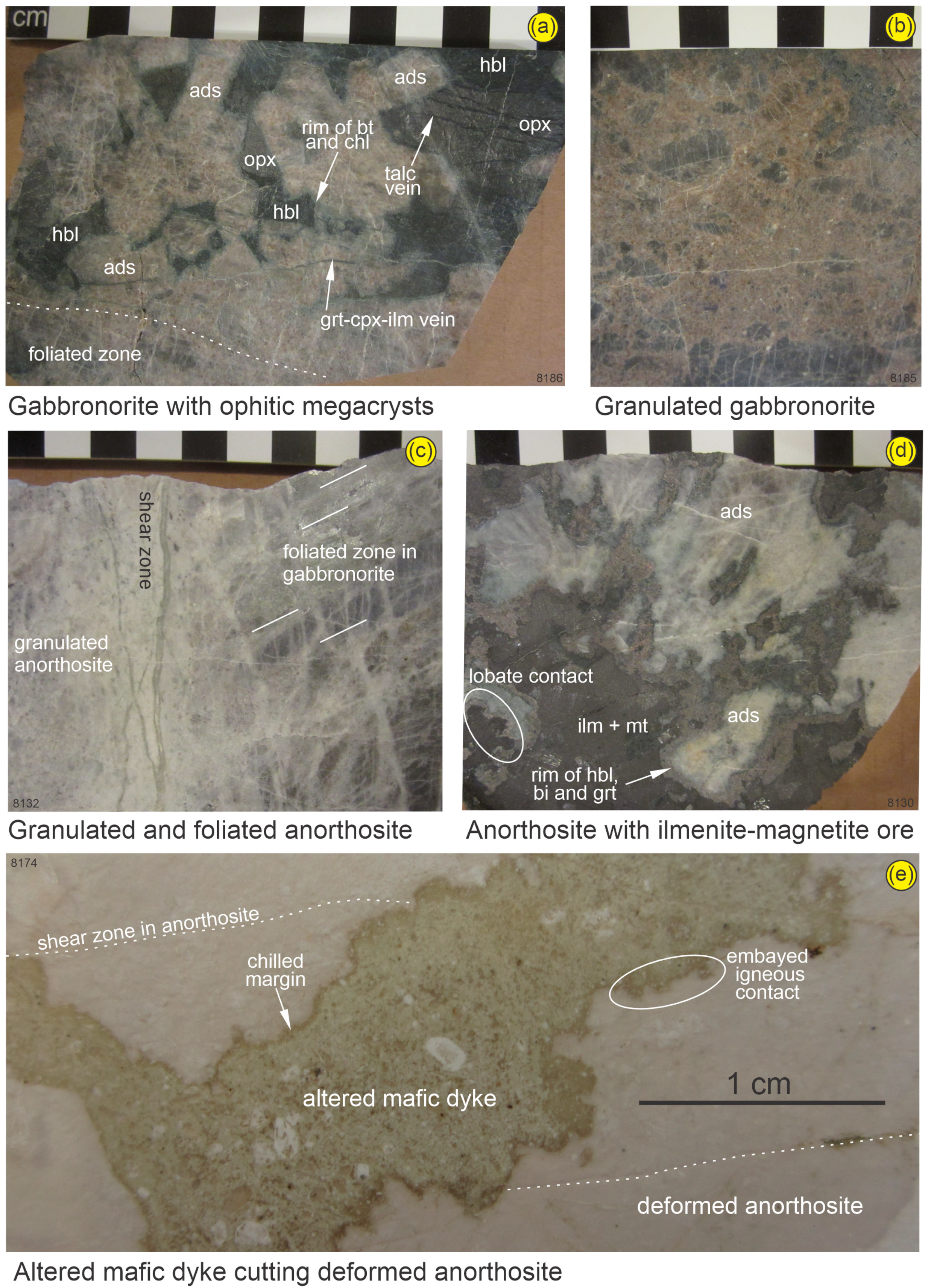
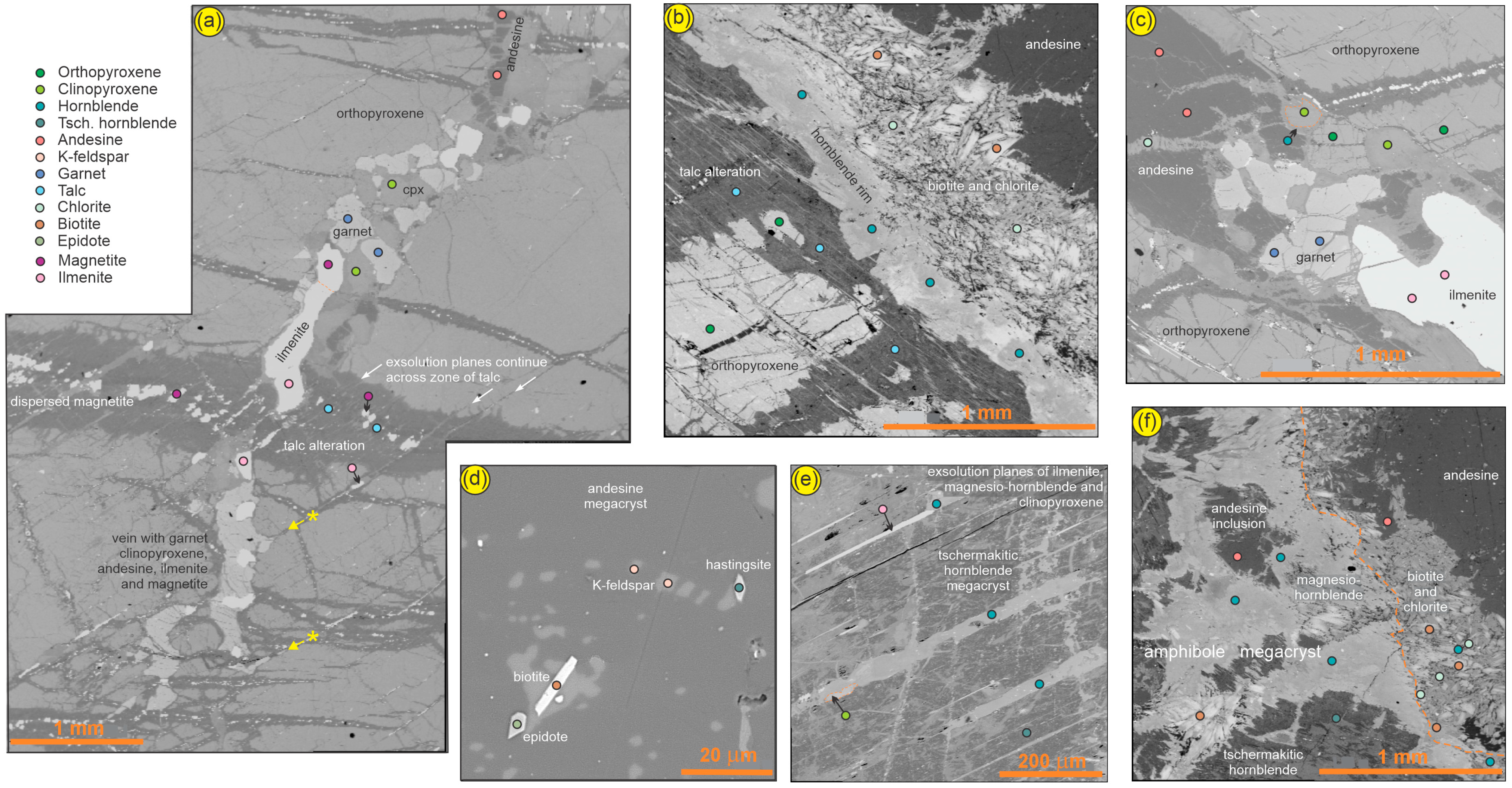

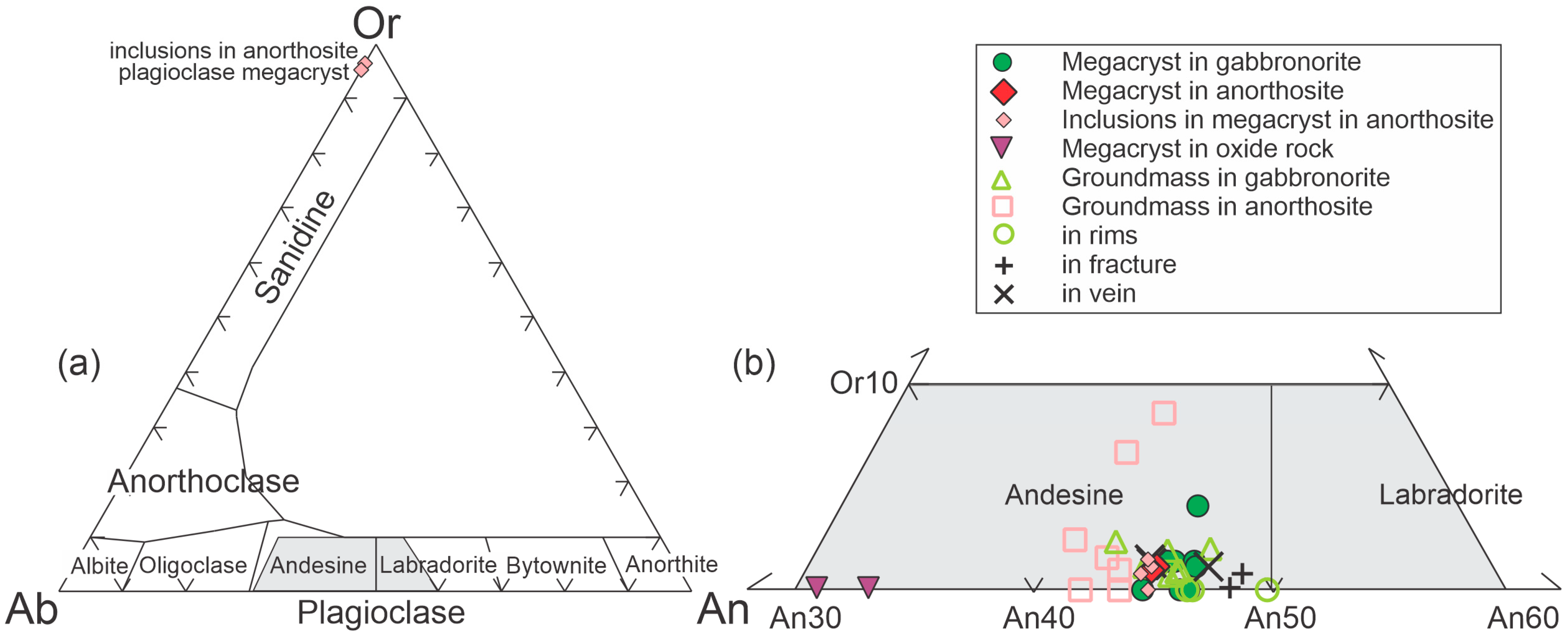


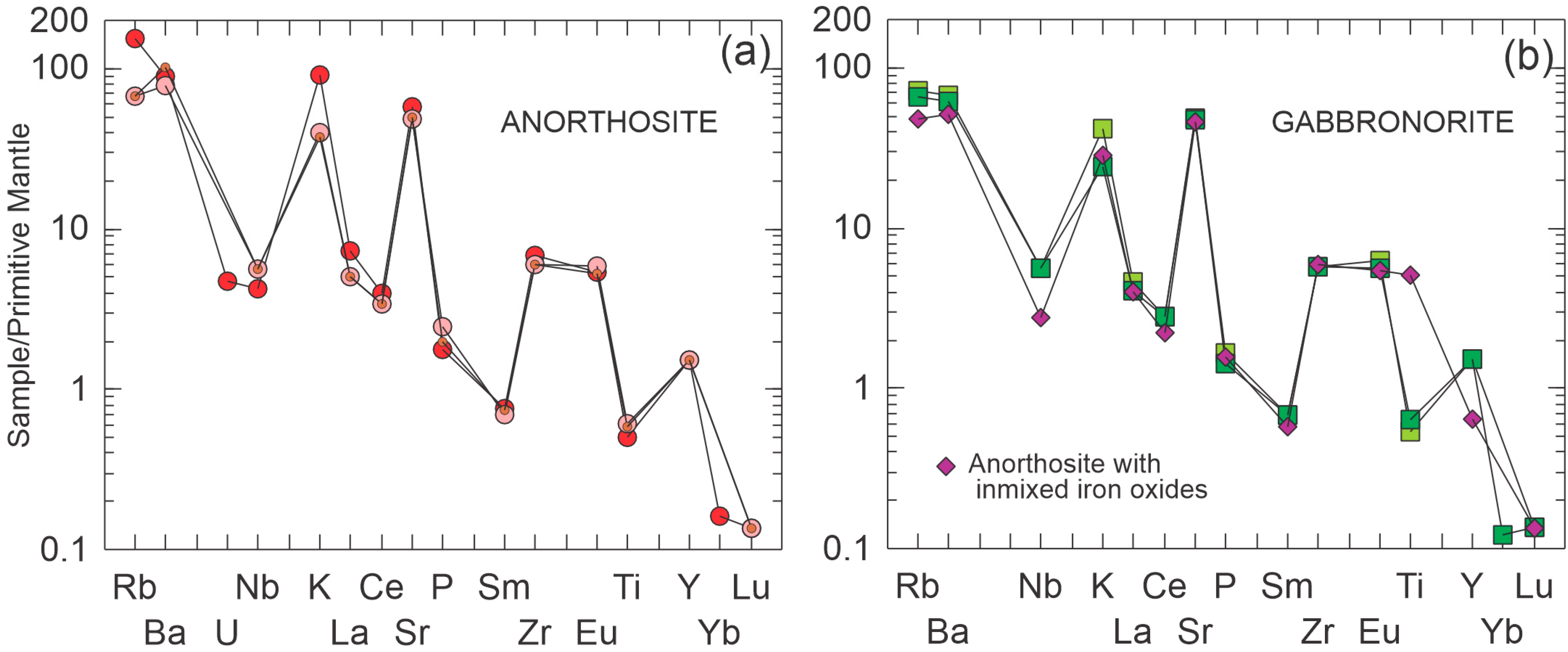
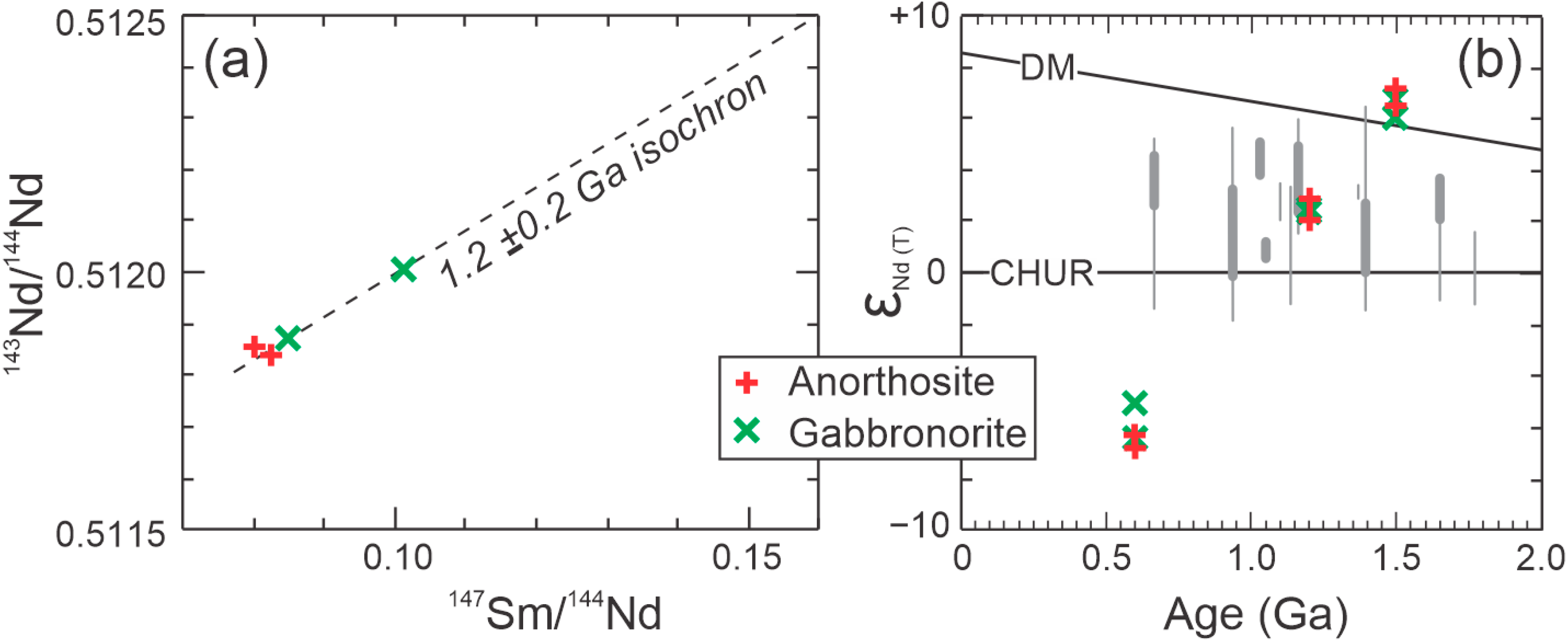

| Rock Type | an | an | an | an | an + | gn | gn | gn | gn |
|---|---|---|---|---|---|---|---|---|---|
| Sample | 8127 | 8128 | 8150 | 8154 | 8157 | 8129 | 8153 | 8185 | 8187 |
| Major oxides (wt%) | |||||||||
| SiO2 | 56.09 | 54.85 | 55.3 | 55.47 | 51.19 | 54.90 | 54.45 | 55.75 | 53.20 |
| TiO2 | 0.13 | 0.38 | 0.13 | 0.12 | 1.10 | 0.18 | 0.12 | 0.14 | 0.32 |
| Al2O3 | 26.88 | 27.49 | 27.04 | 26.49 | 25.01 | 25.62 | 25.98 | 26.92 | 21.08 |
| Fe2O3t | 1.26 | 2.32 | 0.61 | 0.58 | 6.65 | 2.30 | 0.64 | 1.28 | 6.83 |
| MnO | 0.02 | 0.02 | 0.01 | 0.00 | 0.03 | 0.03 | 0.01 | 0.02 | 0.11 |
| MgO | 0.44 | 0.32 | 0.19 | 0.19 | 0.62 | 2.04 | 0.15 | 0.95 | 7.13 |
| CaO | 8.21 | 8.84 | 8.14 | 8.18 | 7.55 | 8.21 | 8.53 | 8.61 | 6.85 |
| Na2O | 5.67 | 5.43 | 5.87 | 5.67 | 5.19 | 5.32 | 5.63 | 5.5 | 3.73 |
| K2O | 1.12 | 0.86 | 1.18 | 1.04 | 0.85 | 0.69 | 1.21 | 0.75 | 0.53 |
| P2O5 | 0.04 | 0.03 | 0.04 | 0.03 | 0.03 | 0.03 | 0.04 | 0.03 | 0.03 |
| L.O.I. | 0.60 | 0.49 | 0.20 | 0.84 | 0.70 | 1.01 | 1.83 | 0.76 | 0.61 |
| Total | 100.46 | 101.03 | 98.71 | 98.61 | 98.92 | 100.33 | 98.59 | 100.71 | 100.42 |
| Trace elements (ppm) | |||||||||
| Ba | 713 | 515 | 483 | 229 | 359 | 261 | 467 | 432 | 302 |
| Rb | 43 | 40 | 47 | 47 | 31 | 40 | 46 | 42 | 29 |
| Sr | 1044 | 1007 | 1091 | 1023 | 984 | 923 | 1024 | 996 | 696 |
| Y | 7 | 4 | 8 | 6 | 3 | 7 | 7 | 7 | 6 |
| Zr | 67 | 65 | 70 | 64 | 67 | 61 | 64 | 64 | 57 |
| Nb | 4 | 3 | 4 | 4 | 2 | 3 | 4 | 4 | 3 |
| Th | 1 | 2 | 2 | 3 | b.d. | b.d. | 2 | b.d. | b.d. |
| Pb | 5 | 4 | 8 | 7 | 4 | 6 | 7 | 7 | 2 |
| Ga | 23 | 22 | 23 | 24 | 19 | 22 | 23 | 23 | 18 |
| Zn | b.d. | 14 | b.d. | b.d. | 39 | 19 | b.d. | 4 | 61 |
| Cu | 20 | 8 | 9 | 11 | 47 | 7 | 8 | 6 | 4 |
| Ni | 49 | 27 | 24 | 26 | 104 | 33 | 21 | 24 | 65 |
| V | 26 | 51 | 12 | b.d. | 193 | 32 | 10 | b.d. | 75 |
| Cr | 8 | 27 | 10 | 7 | 108 | 23 | 8 | 19 | 114 |
| Co | b.d. | b.d. | b.d. | b.d. | 22 | 4 | b.d. | b.d. | 34 |
| Sc | b.d. | b.d. | 4 | 3 | b.d. | b.d. | b.d. | b.d. | 6 |
| La | 19 | 13 | 17 | 14 | 12 | 15 | 12 | 22 | 15 |
| Ce | 61 | b.d. | 18 | 52 | 32 | b.d. | 37 | b.d. | 21 |
| Nd | 15 | 11 | 9 | 7 | 13 | 5 | 8 | 14 | 10 |
| Sample | Lithology | Measured | Calculated | ||||||
|---|---|---|---|---|---|---|---|---|---|
| Sm ppm | Nd ppm | 147Sm/ 144Nd | 143Nd/ 144Nd | t DM (Ga) | ε0.6 CHUR | ε1.2 CHUR | ε1.5 CHUR | ||
| 8217 | anorthosite | 0.29 | 2.21 | 0.0802 | 0.511856 | 1.35 | −6.33 | 2.66 | 7.18 |
| 8131A | anorthosite | 0.25 | 1.84 | 0.0825 | 0.511839 | 1.39 | −6.84 | 1.97 | 6.40 |
| 8131B | gabbronorite | 0.32 | 2.27 | 0.0848 | 0.511869 | 1.38 | −6.43 | 2.20 | 6.54 |
| 8187 | gabbronorite | 0.3 | 1.77 | 0.1013 | 0.512006 | 1.40 | −5.02 | 2.34 | 6.04 |
Disclaimer/Publisher’s Note: The statements, opinions and data contained in all publications are solely those of the individual author(s) and contributor(s) and not of MDPI and/or the editor(s). MDPI and/or the editor(s) disclaim responsibility for any injury to people or property resulting from any ideas, methods, instructions or products referred to in the content. |
© 2024 by the authors. Licensee MDPI, Basel, Switzerland. This article is an open access article distributed under the terms and conditions of the Creative Commons Attribution (CC BY) license (https://creativecommons.org/licenses/by/4.0/).
Share and Cite
Pe-Piper, G.; Piper, D.J.W.; Dessureau, G. Mineralogy of the Steel Mountain Anorthosite Complex, Western Newfoundland Appalachians, Canada: Petrogenesis and Tectonic Affinity. Minerals 2024, 14, 81. https://doi.org/10.3390/min14010081
Pe-Piper G, Piper DJW, Dessureau G. Mineralogy of the Steel Mountain Anorthosite Complex, Western Newfoundland Appalachians, Canada: Petrogenesis and Tectonic Affinity. Minerals. 2024; 14(1):81. https://doi.org/10.3390/min14010081
Chicago/Turabian StylePe-Piper, Georgia, David J. W. Piper, and Gilles Dessureau. 2024. "Mineralogy of the Steel Mountain Anorthosite Complex, Western Newfoundland Appalachians, Canada: Petrogenesis and Tectonic Affinity" Minerals 14, no. 1: 81. https://doi.org/10.3390/min14010081
APA StylePe-Piper, G., Piper, D. J. W., & Dessureau, G. (2024). Mineralogy of the Steel Mountain Anorthosite Complex, Western Newfoundland Appalachians, Canada: Petrogenesis and Tectonic Affinity. Minerals, 14(1), 81. https://doi.org/10.3390/min14010081







